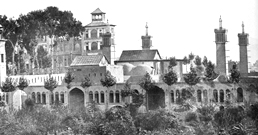A few years ago, passers-by in Tajrish Square in north Tehran could not fail to notice the appearance of a colossal board erected by the Municipality. The image on the board, copied from a photo taken in the early Pahlavi years, depicted the same square surrounded by the dense foliage of plane trees and lush gardens. The irony was that several huge high-rise buildings, under construction with the permission of the same Municipality, were poking their unsightly heads from behind this picturesque board. They were burying the last remnants of those trees under tons of concrete and iron.
This sums up the fate of Tehran’s trees and gardens through the course of the last century and particularly the last few decades when the process has been relentlessly accelerated. A small village seven centuries ago, Tehran was famous for its pomegranate orchards. As the village grew bigger, so did the size and number of its gardens. Even as a city in the 17th century, only a quarter of it was built up and the rest was mainly devoted to gardens.
There was a gradual expansion of the city during the following two centuries, especially from the early 19th century onwards when it was chosen as the capital by the new dynasty of the Qajars. But this growth was matched by the creation of new green spaces so that it lost none of its reputation for a verdant oasis of gardens and orchards, lying at the foot of the Alborz mountains whose streams provided it with an abundant water supply. Many extensive gardens were created during the reign of Naseroddin Shah, some of which now survive only in the names of the streets and neighbourhoods of present day Tehran.
The decline started after Tehran’s population had begun to increase more rapidly in the first decades of the twentieth century, and the gardens began to be broken up to make room for houses. The process intensified during the half century of Pahlavi rule, and soon the only surviving green areas were to be found outside Tehran in various small villages such as Vanak, Evin, Qolhak, Zargandeh etc. But soon these were not spared either, and towards the end of this period the onslaught on the surrounding villages had already begun.
There was a marked acceleration of this trend after the revolution, with the rapid increase of the population and migration from provincial cities and the countryside to the capital. Once more, beautiful trees and precious gardens fell victim to the property developers’ bulldozers, and the villages where they once used to grow are now part of the jam-packed streets of present day Tehran.
In this multimedia report, the historian and author of the book ‘A Social and Cultural History of Tehran’, Dr. Naser Takmil Homayoun, tells us the story of Tehran’s trees and gardens through the ages. We can see at the same time some of the rare photographs kept at the Golestan Palace archives, showing the gardens that once adorned Tehran and Shemiran during the Qajar period.


